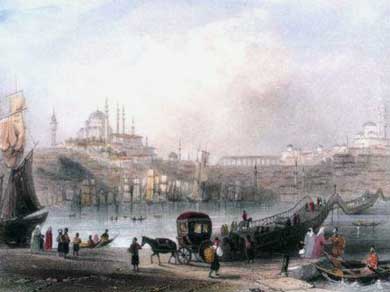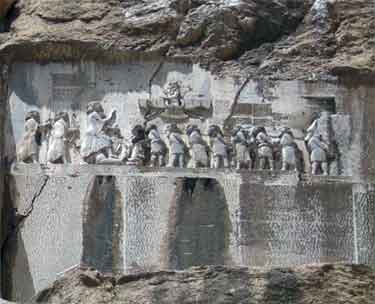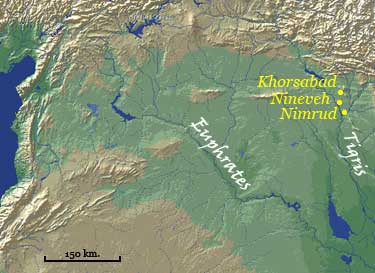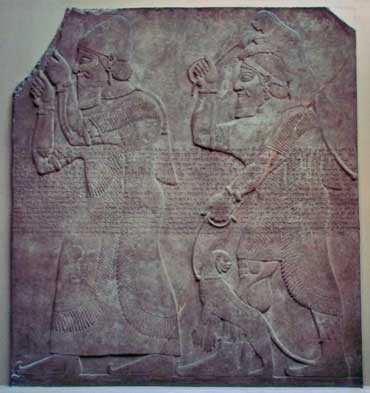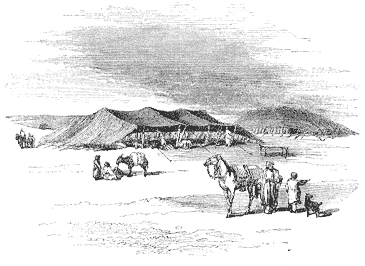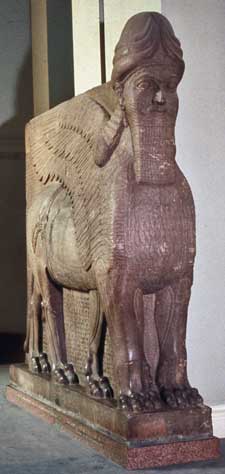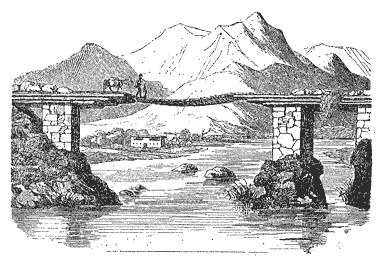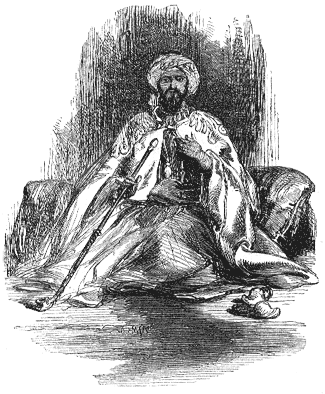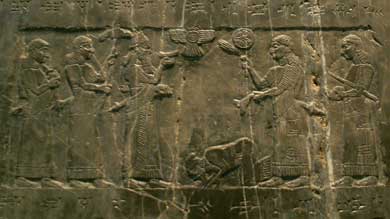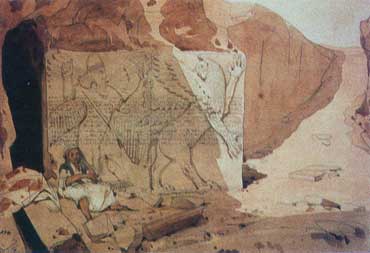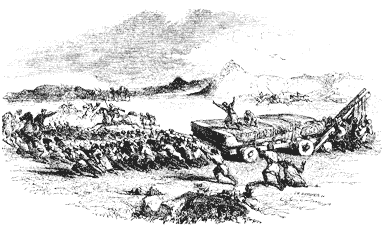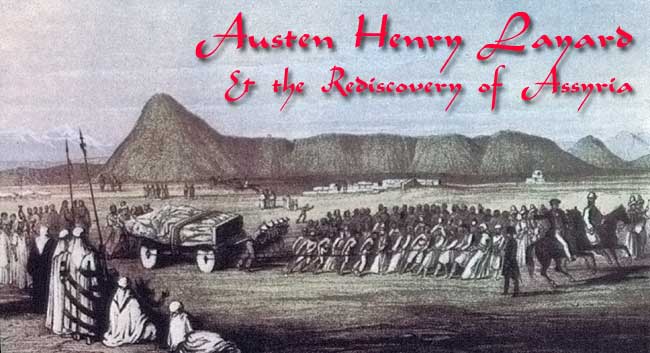
Canning & Nimrud
Istanbul
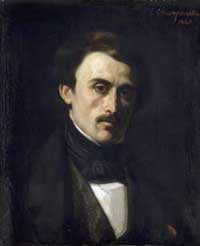 Back in Baghdad, Layard finally received letters from home and had to address the issue of his future. Circumstances in Ceylon (the bankruptcy of his uncle there) made the prospects look less bright in that direction and his wealthy uncle, Benjamin Austen, was unwilling to make any guarantees for his future in London. He spent much of his time writing a long report on his observations in Khuzistan for the Royal Geographical Society. In the end, it was his other experiences in Khuzistan, which offered him an opportunity, for the Persian campaign against the Bakhtiaris and Marsh Arabs led to a larger conflict with Turkey. Colonel Taylor, the Resident, was keen to have Britain intervene on the side of Turkey and sent Layard to Istanbul with reports. On the way, he stopped at Mosul where he met the new French Consul, Paul Émile Botta (above left). Part of Botta's mission was to acquire antiquities for the Louvre and he informed Layard of his intention to begin excavations at the mound of Küyünjik, which lay across the river and, as it turned out, was the site of ancient Nineveh.
Back in Baghdad, Layard finally received letters from home and had to address the issue of his future. Circumstances in Ceylon (the bankruptcy of his uncle there) made the prospects look less bright in that direction and his wealthy uncle, Benjamin Austen, was unwilling to make any guarantees for his future in London. He spent much of his time writing a long report on his observations in Khuzistan for the Royal Geographical Society. In the end, it was his other experiences in Khuzistan, which offered him an opportunity, for the Persian campaign against the Bakhtiaris and Marsh Arabs led to a larger conflict with Turkey. Colonel Taylor, the Resident, was keen to have Britain intervene on the side of Turkey and sent Layard to Istanbul with reports. On the way, he stopped at Mosul where he met the new French Consul, Paul Émile Botta (above left). Part of Botta's mission was to acquire antiquities for the Louvre and he informed Layard of his intention to begin excavations at the mound of Küyünjik, which lay across the river and, as it turned out, was the site of ancient Nineveh.
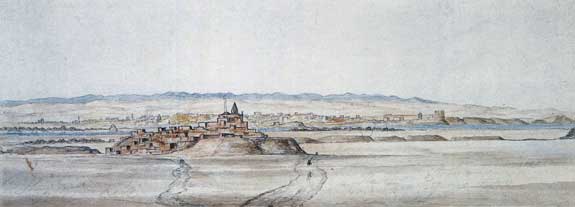
View of the Mounds of Nineveh from the East with Mosul in the distance (Frank Cooper)
Layard arrived in the Turkish capital in July of 1842, in Bakhtiari dress:
I disembarked from the steamer in the Golden Horn. Having secured a room, and deposited my scant luggage, I engaged a caïque to take me to Buyukdereh, where Sir Stratford Canning, the British Ambassador, was then residing. On arriving there I presented myself at the Embassy and delivered my letter for the Ambassador to a servant. I was told to wait, which I did for a considerable time. At length a fashionably-dressed young gentleman appeared, asked me roughly for the dispatches of which I was the bearer, informed me that the Ambassador was too much occupied to see any one, and turning on his heel left the room without deigning to listen to what I had to say.
But within a few hours he received word from the ambassador himself and had a long interview with him the next day, eventually offering him a position on his staff—albeit an unofficial one.
Layard & Canning
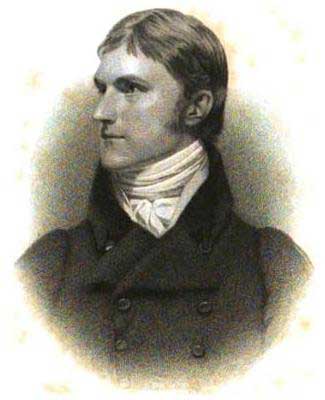 Sir Stratford Canning (right) was a very commanding figure, tall and handsome with firm convictions and a certainty in his own “rightness”. He was adamantly opposed to any expansion of Russian influence into the Near East and often got into hot water with his superiors in Whitehall on that account. He was convinced of the innate superiority of the British way of life and had a tendency to treat all foreigners as inferiors to varying degrees. Although he tended to be pro-Ottoman he was more than a little condescending towards the Turks whom he thought of as somewhat naughty children who had to be told what was good for them. As Canning's agent, Layard found it impossible to get any sort of official standing and remained simply a member of the ambassadors personal staff, whose wages were paid out of his pocket.
Sir Stratford Canning (right) was a very commanding figure, tall and handsome with firm convictions and a certainty in his own “rightness”. He was adamantly opposed to any expansion of Russian influence into the Near East and often got into hot water with his superiors in Whitehall on that account. He was convinced of the innate superiority of the British way of life and had a tendency to treat all foreigners as inferiors to varying degrees. Although he tended to be pro-Ottoman he was more than a little condescending towards the Turks whom he thought of as somewhat naughty children who had to be told what was good for them. As Canning's agent, Layard found it impossible to get any sort of official standing and remained simply a member of the ambassadors personal staff, whose wages were paid out of his pocket.
Both men supported Turkey in the boundary dispute with Persia and both supported the progressive, reformist element in the Turkish ruling class, positions that ran counter to the prevailing policies of Lord Aberdeen's government in London. During this period Layard received regular correspondence from Botta, describing the new excavations that he was conducting at the site of Khorsabad to the north of 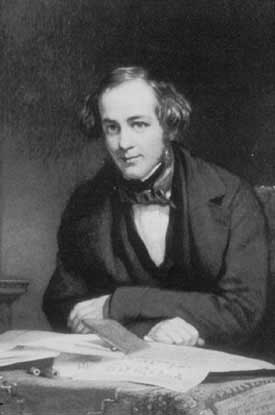 Mosul. The results so far had been spectacular, particularly the carved reliefs and statues of huge human-headed, winged bulls. He urged Layard to join him in the project—but the latter was forced to decline. However, he did use the information provided by Botta to publish a series of articles in the Malta Times, which excited great interest in Britain. He also heard from Henry Rawlinson, the new Resident in Baghdad, who expressed interest in Layard's experiences.
Mosul. The results so far had been spectacular, particularly the carved reliefs and statues of huge human-headed, winged bulls. He urged Layard to join him in the project—but the latter was forced to decline. However, he did use the information provided by Botta to publish a series of articles in the Malta Times, which excited great interest in Britain. He also heard from Henry Rawlinson, the new Resident in Baghdad, who expressed interest in Layard's experiences.
Rawlinson was an Indian Army man who had served as military advisor to the Shah of Persia in the 1830's. He was fascinated by Oriental languages and had used his spare time to make a copy of the inscription cut into the rock face at Bisitun. The inscription was in cuneiform, the same writing system, which was used on the clay, tablets and inscriptions used by the ancient inhabitants of Mesopotamia. The text was in three different languages, one of which was in an ancient form of Persian. Persian, of course, is still spoken today and the cuneiform characters were used alphabetically, with each character standing for an individual letter. Using this as his starting point, Rawlinson and others were beginning to make progress in deciphering the other two. One of these turned out to be Babylonian essentially the same as the inscriptions found in Assyria. However, it would still be several years before his understanding was sufficient to be able to read it with any degree of confidence.

Copy of part of the Bisitun Inscription
Layard tried to interest Canning in an excavation at Nimrud and finally convinced him to support his plans to begin in the autumn of 1845—it would have been a personal triumph for him, as he later wrote his wife:
I am quite proud of my public spirit in the cause of antiquity and fine art. But I must not ruin either you or the children; and I propose to call in the aid of the Government— whether Whig or Tory—to accomplish what may easily prove beyond my reach. Now you must be tired, dead tired of all this, and perhaps you think me crazy for caring so much about such trifles, but they are trifles for which colleges universities and nations would take each other by the cars, and as Major Rawlinson tells me, the inscriptions are likely to throw much light upon Scripture history, particularly on our old friend Tiglath-Pileser.
Nimrud/Kalhu
Layard returned to Mosul in October 1845 with £150 in expense money and a set of instructions from Canning, who clearly considered Layard to simply be his agent:
I rely upon Mr Layard’s obliging attention to the following points:
To keep me informed of his operations, and of any objects of sufficient interest and curiosity which he may see or discover.
To keep clear of political and religious questions, and as much as possible of Missionaries, or native chiefs and tribes regarded with enmity or jealousy by the Turkish authorities.
To cultivate the goodwill of the Pashas and others of the Sultan's functionaries by all becoming means.
To bear in mind that his professed occupation will he that of a traveller, fond of antiquities, of picturesque scenery, and of the manners peculiar to Asia.
Not to start on his return without a previous communication with me subsequent to his first inquiries and attempts at discovery.
In case of success to give me early and exact information as to the nature of the objects discovered, & the best means of removal etc with an estimate of cost, doing what he can to obtain the necessary help on the spot.
He was met by an English merchant named Henry Ross and the Vice-Consul Christian Rassam—he would need to rely on their help as he had no firman (official permission from the Ottoman government) to dig. The three of them were very surreptitious in their moves—Rassam used the construction of a house as a pretext to acquire tools and Ross went on a “hunting trip” to Nimrud
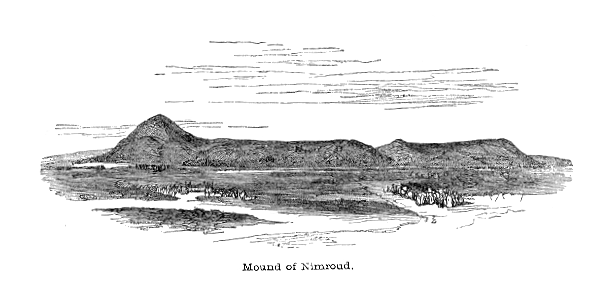
Layard's Drawing of the Mound at Nimrud
while Layard followed with the tools on a kelek. They based themselves at the nearby village of Naifa, which they found almost deserted due to the depredations of the Pasha's soldiers and tax-collectors. They were well-received by the local sheikh and his family and, when they explained their intentions, the he agreed to collect some workmen from one of the neighbouring villages. Layard was filled with excitement at the prospect before him:
Visions of palaces underground, of gigantic monsters, of sculptured figures, and endless inscriptions, floated before me. After forming plan after plan for removing the earth, and extricating these treasures, I fancied myself wandering in a maze of chambers from which I could find no outlet. Then again, all was reburied, and I was standing on the grass-covered mound. Exhausted, I was at length sinking into sleep, when hearing the voice of Awad, I rose from my carpet, and joined him outside the hovel. The day already dawned; he had returned with six Arabs, who agreed for a small sum to work under my direction.
(Layard I 1849, vol. I: 25)
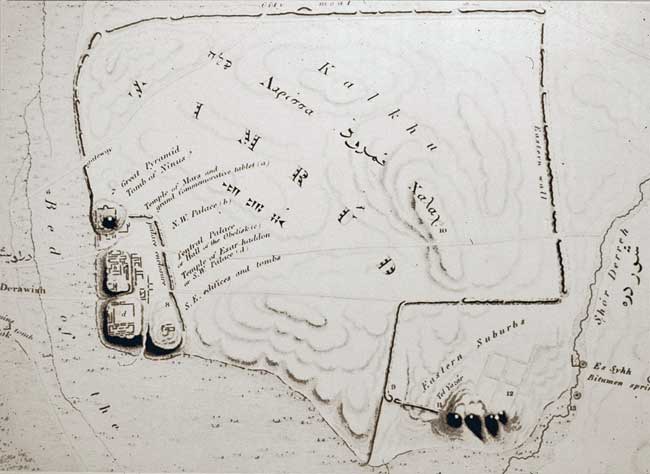
Plan of Kalhu/Nimrud by Captain Felix Jones (1852)
The layout of the site is trapezoidal covering some 357 hectares enclosed by 8 km of walls. The Acropolis lies in the southwest corner and covers approximately 24 hectares. The Acropolis was what the Arabs called a tell, an artificial mound made up of the superimposed remains of hundreds, if not thousands, of years of occupation. In the southeast corner was an area now known as Fort Shalmaneser (labelled Eastern Suburbs in the plan above), which served as a barracks and arsenal. This part of the site was not actually excavated until the last century, when it was discovered to 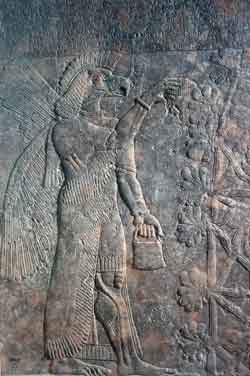 have been entirely enclosed by walls and not just on two sides as shown in the plan. At first, Layard believed that Nimrud was the site of Nineveh itself at first but he was wrong. When decipherment eventually reached the point where he was able to read the inscriptions it turned out that the name of the city of Kalhu, known as Calah in the Old Testament. It takes its modern name from Nimrod, the mighty hunter of the Old Testament (and of considerable folklore), the great-grandson of Noah and king of Shinar (Sumer).
have been entirely enclosed by walls and not just on two sides as shown in the plan. At first, Layard believed that Nimrud was the site of Nineveh itself at first but he was wrong. When decipherment eventually reached the point where he was able to read the inscriptions it turned out that the name of the city of Kalhu, known as Calah in the Old Testament. It takes its modern name from Nimrod, the mighty hunter of the Old Testament (and of considerable folklore), the great-grandson of Noah and king of Shinar (Sumer).
The first thing Layard and his companions did was to survey the upper surface of the Acropolis, the most promising area to dig, where they found pieces of broken alabaster carved with reliefs of both a religious and secular nature. The example shown here (left) depicts an eagle-headed winged genie applying pollen (?) to a sacred tree. Eventually, while unsuccessfully trying to extract a particularly large block in the north-western part of the site, they uncovered a room, with an inscription running around the walls. Also, since it appeared that the alabaster fragments were particularly concentrated in the southwest corner of the tell, Layard decided to do some probing there and managed to find another room. So, on his first day he managed to locate and begin excavations at two of the major palaces at the site. His excitement was tempered by the fact that the slabs had been badly damaged by fire—those in the south-western area actually crumbled to bits when they were exposed to the air. The same sort of fire damage was found by Botta at Küyünjik and was undoubtedly due to the destruction of Assyria at the end of the 7th century BC as described in the Old Testament.
After a week, Layard returned to Mosul to confront the pasha, Mohammed Keritli Oglu, who had gotten wind of his activities. Pasha Mohammed was a one-eyed, one-eared brute of a man who, when on his way to take up his position in Mosul, reintroduced the dish parassi, a tax on the villages where he stayed to compensate him for the wear on his teeth caused by having to eat their humble food. When he arrived in Mosul, he seduced the community leaders with promises of fair play and then had them all beheaded. His favourite trick was to spread word of his own demise and then confiscate the property of those who seemed unduly happy. However, the main obstacle to Layard’s plans was not the pasha but the qadi, the religious leader of the town, who resented the growth of European influence in his community—he had already incited a mob to destroy the British consulate.
By now, Layard had expanded his workforce from 6 to 30 men—mainly Nestorian Christians who had fled to this region to escape the Kurds in their Zagros homeland and were desperate for employment. Into the second week of excavation, they came upon their first complete slab bearing carved reliefs:
The Arabs were no less excited than myself by the discovery; and notwithstanding a violent shower of rain, working until dark, they completely exposed to view two slabs. On each slab were two has-reliefs, separated from one another by a band of inscriptions. The 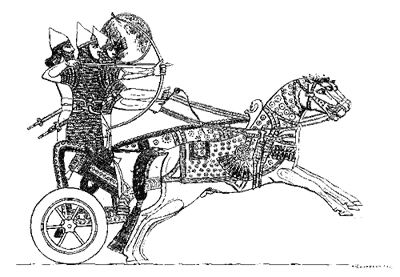 subject on the upper part of No. 1. was a battle scene. Two chariots, drawn by horses richly caparisoned, were each occupied by a group of three warriors; the principal person in both groups was beardless and evidently a eunuch. He was clothed in a complete suit of mail, and wore a pointed helmet on his head, from the sides of which fell lappets covering the ears, the lower part of the face, and the neck. The left hand, the arm being extended, grasped a how at full stretch; whilst the right, drawing the string to the ear, held an arrow ready to be discharged. A second warrior urged, with the reins and whip, to the utmost of their speed three horses, which were galloping over the plain. A third, without helmet, and with flowing hair and beard, held a shield for the defence of the principal figure. Under the horses’ feet, and scattered about the relief, were the conquered, wounded by the arrows of the conquerors.
subject on the upper part of No. 1. was a battle scene. Two chariots, drawn by horses richly caparisoned, were each occupied by a group of three warriors; the principal person in both groups was beardless and evidently a eunuch. He was clothed in a complete suit of mail, and wore a pointed helmet on his head, from the sides of which fell lappets covering the ears, the lower part of the face, and the neck. The left hand, the arm being extended, grasped a how at full stretch; whilst the right, drawing the string to the ear, held an arrow ready to be discharged. A second warrior urged, with the reins and whip, to the utmost of their speed three horses, which were galloping over the plain. A third, without helmet, and with flowing hair and beard, held a shield for the defence of the principal figure. Under the horses’ feet, and scattered about the relief, were the conquered, wounded by the arrows of the conquerors.
The other relief was similarly decorated and was found upside down and Layard concluded that it and its companion were brought from elsewhere to be re-carved. He was right on that score—the building, as we now know, was begun by Esarhaddon (680-669 BC) but never seems to have been completed—other reliefs were found facing the wall.
That evening the leader of the local militia, a man named Daoud Agha, arrived with orders from the Pasha to stop the dig—apparently the qadi had pointed out to the latter that the site was Muslim cemetery. He wrote Canning, urging him to apply for a proper firman so that he would not be further harassed but Canning prevaricated. Meanwhile, he continued to work in secret while Daoud turned a blind eye—the latter was mortally offended by the fact that the Pasha had ordered his men to remove tombstones from other cemeteries to set up on the tell. Eventually, Mohammed Keritli Oglu was deposed by the Sultan and a new, more moderate Pasha, Ismail, was appointed in his place and the situation eased somewhat.
When Layard had first arrived in Mosul he had been given funds by Canning for two months work and now these were beginning to run out. The new Pasha was sympathetic to Layard but, since the qadi was organizing a campaign directed against the excavations, he thought it would be best if Layard called a temporary halt to his activities. In the event, Layard reduced the level of activity but did not stop work altogether. He left a skeleton crew behind to continue limited operations while he went off to visit some of the local Bedouin tribes, especially the Abu Salman tribe who lived in the vicinity. He was particularly impressed with their sheikh, Abd-ur-Rahman:
He was one of the handsomest Arabs I ever saw; tall, robust, and well-made, with a countenance in which intelligence was no less marked than courage and resolution. On his head he wore a turban of dark linen, from under which a many-coloured handkerchief fell over his shoulders; his dress was a simple white shirt, descending to the ankles, and an Arab cloak thrown loosely over it. Unlike Arabs in general, he had shaved his beard; and although he could scarcely be much beyond forty, I observed that the little hair which could he distinguished from under his turban was grey. He received me with every demonstration of hospitality, and led me to the upper place, divided by a goat-hair curtain from the harem. The tent was capacious; half was appropriated for the women, the rest formed the place of reception, and was at the same time occupied by two favourite mares and a colt. A few camels were kneeling on the grass around, and the horses of the strangers were tied by the halter to the tent-pins. From the carpets and cushions, which were spread for me, stretched on both sides a long line of men of the most motley appearance, seated on the hare ground. The Sheikh himself, as is the custom in some of the tribes, to show his respect for the guest, placed himself at the furthest end; and could only he prevailed upon, after many excuses and protestations, to share the carpet with me. In the centre of the group, near a small fire of camel's dung, crouched a half-naked Arab, engaged alternately in blowing up the expiring embers, and in pounding the roasted coffee in a copper mortar, ready to replenish the huge pots which stood near him.
(Layard 1849, vol. I: 56-7)
At about this time he received word that the French had applied for a firman to excavate at Küyünjik (Nineveh) and wrote to Canning, stating that it would be a blow to national pride if this were allowed to happen.
Operations at Nimrud, meanwhile, had shifted to the north-western part of the mound where their work was soon rewarded by the discovery of a large head. Although partly buried it was clear that it belonged to one of the large winged bull or lion figures that guarded the more important doorways and gates of the palace. His workmen were dismayed and extremely agitated by the appearance of the monster, which they 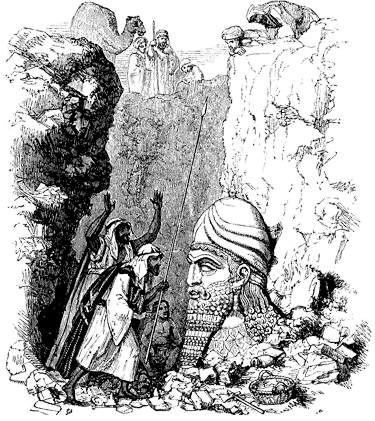 took for a jinn:
took for a jinn:
I was not surprised that the Arabs had been amazed and terrified at this apparition. It required no stretch of imagination to conjure up the most strange fancies. This gigantic head, blanched with age, thus rising from the bowels of the earth, might well have belonged to one of those fearful beings which are pictured in the traditions of the country, as appearing to mortals slowly ascending from the regions below.
But Abd-ur-Rahman convinced them that it was an antediluvian idol and had been one of,
those infidel giants of whom the Prophet—peace be with him!—has said that they were higher than the tallest date tree; this is one of the idols which Noah—peace be with him!—cursed before the flood!
He immediately wrote Canning of the momentous discovery and urging him once again to act on the matter of a firman and more funding-pointing out the enormous public relations coup it would be. More immediate problems were at hand, for one of the workers had been terrified and had run all the way to Mosul to announce that the ancient giant Nimrod had returned:
He had scarcely checked his speed before reaching the bridge. Entering breathless into the bazaars, he announced to every one he met that Nimrod had appeared. The news soon got to the cars of the Cadi, who, anxious for a fresh opportunity to annoy me, called the Mufti and the Ulema together, to consult upon this unexpected occurrence. Their deliberations ended in a procession to the Governor, and a formal protest, on the part of the Mussulmans of the town, against proceedings so directly contrary to the laws of the Koran. The Cadi had no distinct idea whether the bones of the mighty hunter had been uncovered, or only his image; nor did Ismail Pasha very clearly remember whether Nimrod was a true-believing prophet, or an Infidel. I consequently received a somewhat unintelligible message from his Excellency, to the effect that the remains should he treated with respect, and be by no means further disturbed; that he wished the excavations to he stopped at once, and desired to confer with me on the subject.
(Layard 1849, vol. I: 67-8)
Excavations were suspended forthwith but Layard won a good deal of local support by throwing a huge party at the site and inviting all of the local Arabs together with the Christians of Mosul to attend. He borrowed some white pavilions from the Pasha and hired troupes of Kurdish musicians and entertainers—jugglers, sword-dancers and clowns—the party lasted until dawn. Abd-ur-Rahman was utterly smitten by one of the guests, the French Consul's wife:
“Wallah”, he whispered to me, “she is the sister of the sun! What would you have more beautiful than that? Had I a thousand purses, I would give them all for such a wife. See!—her eyes are like the eyes of my mare, her hair is bitumen, and her complexion resembles the finest Busrah dates. Anyone would die for a houri like that.”
Layard's financial problems continued and he could not seem to motivate Canning to act although he used every argument he could think of—culture, history, national pride, etc—and was fully supported by Rawlinson. As it happened, Canning was in the midst of trying to transfer responsibility to the government and had already written to the Prime Minister, Sir Robert Peel, in glowing terms:
On the banks of the Tigris not far from Mosil there is a gigantic mound called Nimroud. My agent has succeeded in opening it here and there, and his labours have been rewarded by the discovery of many interesting sculptures, and a world of inscriptions. If the excavation keeps its promise to the end there is much reason to hope that Montagu House [the British Museum] will beat the Louvre hollow.
In the end, the long awaited firman arrived in the form of a letter from the Grand Vizier to the Pasha informing him of Layard's activities and granting the latter permission to continue his excavations and to send the discoveries back to England. The terms were generous and Layard used them to open up some trenches on Küyünjik—over the strenuous objections of the new French Vice-Consul who felt that Botta's activities there had given his country a prior claim.
Layard's troubles with French officialdom were insignificant, however, compared to the brouhaha he incited within the local community. One evening, while returning to Mosul from Küyünjik on the ferry, he had a run in with the qadi who had been praying with a group of holy men at the tomb of Jonah. Insults led to blows and Layard cracked open the head of the qadi with his stick. Only the presence of a pair of soldiers prevented his death at the hands of the cleric's followers. Needless to say, the incident sparked bitter anti-European feelings in the town and Layard had to take refuge in the Pasha's palace. Thanks to the latter's support, the incident eventually blew over and Layard was able to resume work.
By now it was the hottest part of the summer and Layard decided to take an extended trip into the mountains northeast of Mosul from whence many of his Nestorian workmen had come. The Nestorians were a Christian sect, deemed heretical in the West, that had been long settled in the region. Within a few years their community would be all but wiped out by the Kurds (of whom Layard had little good to say). 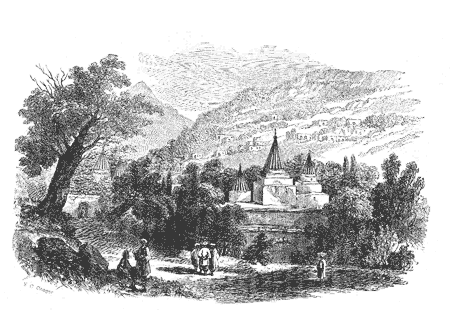 A similar fate would befall another group Layard encountered—the Yezidis. Layard was warmly welcomed by these people and given the great honour of visiting the tomb of Sheikh Adi, the great 12th century mystic who was revered by the Yezidis as their greatest saint, at Lalish (left). It was located in a former Christian monastery north of Mosul and was the scene of a great annual pilgrimage.
A similar fate would befall another group Layard encountered—the Yezidis. Layard was warmly welcomed by these people and given the great honour of visiting the tomb of Sheikh Adi, the great 12th century mystic who was revered by the Yezidis as their greatest saint, at Lalish (left). It was located in a former Christian monastery north of Mosul and was the scene of a great annual pilgrimage.
Little is known about their practices and nothing about their origins. The Yezidi religion combines features of Zoroastrianism, Manichaeism, Judaism, Nestorian Christianity, and Islam. They believed that they were created separately from the rest of mankind and consequently kept themselves strictly segregated from their neighbours. The focus of their worship is Satan who, as the “Peacock Angel”, rules the universe with six other angels. All seven are subordinate to God but the Yezidis believe that the 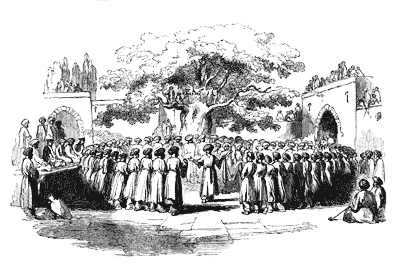 latter has taken no interest in the universe since the Creation. They deny the existence of evil and therefore reject the notion of sin and of damnation. They have a reputation as devil-worshippers but this is based on misunderstanding. They believe that Satan repented of his sin of pride before God, was pardoned and made chief of the angels once again. Layard was one of the few outsiders witness to rites and ceremonies (right) and viewed them with a great deal of sympathy.
latter has taken no interest in the universe since the Creation. They deny the existence of evil and therefore reject the notion of sin and of damnation. They have a reputation as devil-worshippers but this is based on misunderstanding. They believe that Satan repented of his sin of pride before God, was pardoned and made chief of the angels once again. Layard was one of the few outsiders witness to rites and ceremonies (right) and viewed them with a great deal of sympathy.
They had suffered badly under the recent crop of pashas and were naturally very suspicious of Turkish authority. Layard witnessed a campaign in which the Turks captured the main Yezidi settlement and executed the old people who had been left to defend it. The rest of the inhabitants were barricaded in a gully and defended themselves ferociously. The Pasha's troops attacked their position several times but were driven off with heavy losses.
When he returned to Mosul he found a letter from the British Museum appointing him their agent an providing him with some funds, amounting to about £1000. This was a wholly inadequate amount for the job at hand and Layard was deeply offended by their stinginess. He also received a lengthy document from the Trustees, detailing his responsibilities and informing him that he could be promised no further employment once his work in Iraq was finished. It did not improve his mood.
More Discoveries
Layard finally resumed work at Nimrud on November 1st, 1846—concentrating his efforts in the northwest and central parts of the site, where he had already located parts of palaces. He was unable to identify the names of the builders from their inscriptions and had to awkwardly refer to “the Khorsabad king” or “the son of the builder of the North-west Palace”. In the Central Building 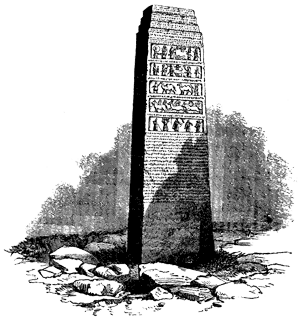 he found stacks of reliefs leaning up against the walls, waiting to be transported elsewhere. In the central part of the site, they recovered a polished basalt stele known as the Black Obelisk. It was just over 2 metres tall with a stepped top and was sculpted on all four sides with 20 small relief panels-mainly depicting foreign princes bringing their tribute to the king:
he found stacks of reliefs leaning up against the walls, waiting to be transported elsewhere. In the central part of the site, they recovered a polished basalt stele known as the Black Obelisk. It was just over 2 metres tall with a stepped top and was sculpted on all four sides with 20 small relief panels-mainly depicting foreign princes bringing their tribute to the king:
It appears to have been erected to celebrate the conquest of some remote country, for amongst the animals represented as brought to the king are the elephant, rhinoceros, lion, Bactrian camel, wild mule, ibex, stag, several species of baboon and monkey etc.-you will observe that the bas reliefs are in many instances repetitions of the larger sculptures in the earlier building of Nimroud, with which it was contemporary.
He could not know that one of the figures shown grovelling before the king was Jehu of Israel—the problem, of course, lay in the inability to read the inscription, in this case a rather lengthy one.
By this time, he and Rawlinson could establish a sequence of royal names but were unable to read so much as one of them. Layard was familiar enough with the formulae to be able to work out a rough sequence of construction—for instance he knew that the king who built the Central Palace was the son of the builder of the Northwest Palace. He had noted that his sequence was supported somewhat by the sculptures which seemed to belong to distinct stylistic phases.
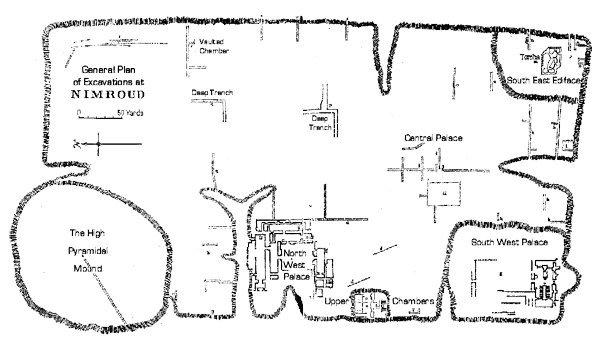
Layard's Plan of the Tell at Nimrud
By April of 1847, in the Northwest Palace alone, he had explored 28 halls and chambers, lined with reliefs, along with 13 pairs of winged bulls or lions. Now it was time to suspend operations and Layard began to organize the shipment of the pick of his finds down the Tigris to Baghdad and thence to Basra and England. He needed to find a lot of rope and mats, to secure and protect the reliefs, and these had to be imported from Syria. When a consignment was stolen by Bedouin 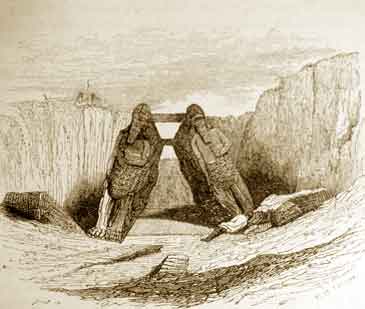 tribesmen, Layard rode out to their camp with a couple of Turkish constables to confront the culprits and, noticing the sheikh’s tent had new ropes, addressed him:
tribesmen, Layard rode out to their camp with a couple of Turkish constables to confront the culprits and, noticing the sheikh’s tent had new ropes, addressed him:
Peace he with you. Your health and spirits are, please God, good. We have long been friends, although it has never yet been my good fortune to see you. I know the laws of friendship; that which is my property is your property, and the contrary. But there are a few things, such as mats, felts, and ropes, which come from afar, and are very necessary to me, whilst they can he of little use to you; otherwise God forbid that I should ask for them. You will greatly oblige me by giving these things to me.
When the sheikh denied he had these things, Layard slapped handcuffs on him and dragged him away from the tent. The following day, his fellow tribesmen produced Layard's goods.
In March he had begun the removal of the bulls:
The men being ready, and all my preparations complete, I stationed myself on top of the high bank of earth over the second bull, and ordered the wedges to he struck out from under the sculpture to he moved. Still, however, it remained firmly in its place. A rope having been passed around it, six or seven men easily tilted it over. The thick, ill-made cable stretched with the strain, and almost buried itself in the earth round which it was coiled. The ropes held well. The mass descended gradually, the Chaldaeans propping it up with the beams. It was a moment of great anxiety. The drums and shrill pipes of the Kurdish musicians increased the din and confusion caused by the war-cry of the Arabs, who were half frantic with excitement. They had thrown off nearly all their garments; their long hair floated in the wind; and they indulged in the wildest postures and gesticulations as they clung to the ropes. The women had congregated on the sides of the trenches, and by their incessant screams, and by the ear-piercing tahlehl, added to the enthusiasm of the men.
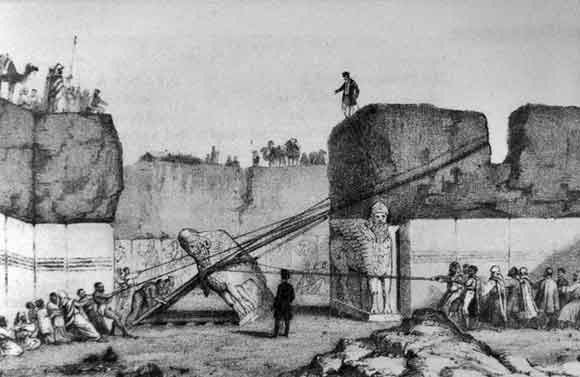
Layard supervising the lowering of the Winged Bulls
The bull once in motion, it was no longer possible to obtain a bearing. The loudest cries could produce were lost in the crash of discordant sounds. Neither the hippopotamus-hide whips of the Cawasses, nor the bricks and clods of earth with which I endeavoured to draw attention from some of the most noisy of the group, were of any avail. Away went the bull, steady enough as long as supported by the props behind; but as it came nearer to the rollers. The beams could no longer he used. The cable and ropes stretched more and more. Dry from the climate, as they felt the strain, they creaked and threw out dust. Water was thrown over them, but in vain, for they all broke together when the sculpture was within four or five feet of the rollers. The bull was precipitated to the ground. Those who held the ropes' thus suddenly released, followed its example, and were rolling, one over the other, in the dust. A sudden silence succeeded to the clamour. I rushed into the trenches, prepared to find the bull in many pieces. It would be difficult to describe my satisfaction when I saw it lying precisely where I had wished to place it and uninjured! The Arabs no sooner got on their legs again, than, seeing the result of the accident, they darted out of the trenches, and, seizing by the hands the women who were looking on, formed a large circle, and, yelling their war-cry with redoubled energy, commenced a most mad dance. The musicians exerted themselves to the utmost; but their music was drowned by the cries of the dancers. Even Abd-ur-rahman shared in the excitement and, throwing his cloak to one of his attendants, insisted upon leading off the dehkhé.
Once removed from the site, they were transported by the same methods Botta had used—Layard even used some of Botta's original ox-carts (the painting underlying the title at the top of the page shows them being moved). They were then loaded onto rafts and floated down the Tigris to Baghdad (below).
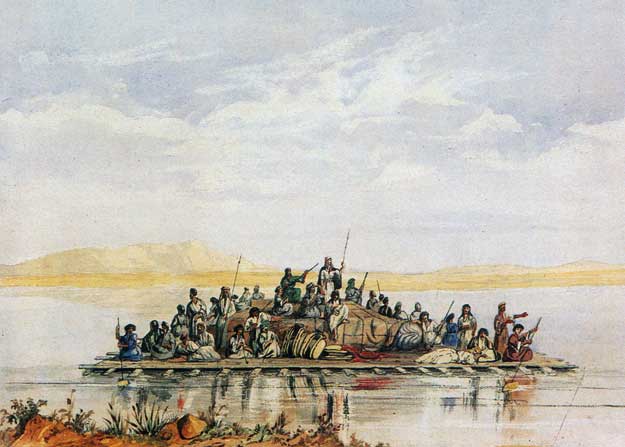
The Bull Colossus floating down the Tigris on a Kelek (by F. C. Cooper)
He had a little time and money left and so he used them to do some preliminary work at Qal’at Shergat (ancient Aššur) and revealed much of the Southwest Palace at Küyünjik. The latter, he believed (quite rightly as it turned out) must belong to one of the kings mentioned in the Old Testament-Sennacherib, Esarhaddon or Tiglath-Pileser. He left Mosul in June of 1847 after bidding a tearful farewell to his workers and their families, taking with him a young friend, Hormuzd Rassam, the younger brother of Christian Rassam, the Vice-Consul.
Suggested Reading
| Larsen, Mögens T. | (1996) | The Conquest of Assyria |
| Layard, A.H. | (1849) | The Monuments of Nineveh |
| (1853) | Discoveries among the ruins of Nineveh and Babylon | |
| (1867) | Nineveh and Babylon A narrative of a second expedition to Assyria, during the years 1849, 1850, and 1851 | |
| (1860) | Inscriptions in the Cuneiform Character, from Assyrian monuments, discovered by A. H. Layard, D.C.L. | |
| (1887) | Early Adventures in Persia, Susiana, and Babylonia | |
| (1894) | A Handbook of Rome and its Environs | |
| (1903) | Autobiography and Letters from his childhood until his appointment as H.M. Ambassador at Madrid | |
| Lloyd, Seton | (1981) | Foundations in the Dust |

